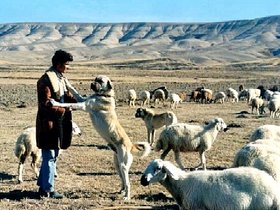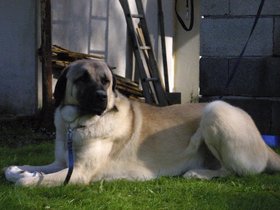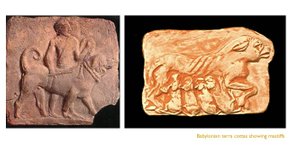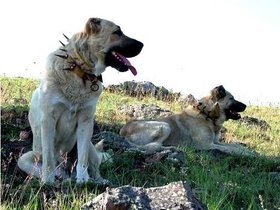The ancient history of the Kangal
The Turkish people claim: the Kangal Dog is an ancient flock-guarding breed, thought to be related to the early mastiff-type dogs depicted in Assyrian art. The breed is named for the Kangal District of Sivas Province in central Turkey where it probably originated. Although the breed has long been associated with the family of the Aga of Kangal, large landholders and chieftains, the majority are bred by villagers who take great pride in the dogs' ability to guard their flocks of sheep and goats from such traditional predators as the wolf, bear and jackal.
The relative isolation of the Sivas-Kangal region has kept the Kangal Dog free of cross-breeding and has resulted in a natural breed of remarkable uniformity in appearance, disposition and behavior. Despite its regional origin, many Turks consider the Kangal Dog as their national dog. Turkish government and academic institutions operate breeding kennels where Kangal Dogs are bred and pedigrees are carefully maintained.
It is known that a few Turkish dogs were brought to the West before any attempt was made to recognize a breed officially; for example, a Mr Buckland is reported to have imported an impressive dog called Arslan into England in the early 1900s.David and Judith Nelson, Americans who studied the dogs while residing in Turkey, imported their first Kangal to the United States in 1985. This dog, and subsequent imports, provided the foundation for the Kangal Dog in the United States.
True Kangal Dogs are from the province of Sivas and the town of Kangal.
Quite how the modern population of large guardian dogs in Anatolia develope is a matter for conjecture and has formed the basis of at least one researchproject (reported by Professor Karadag of Van University at the First International Symposium of the Kangal Dog in 2003).
The proximity of Asiatic Turkey to the ancient territories of Babylon, Assyria and Mesopotamia has led researcher to look for links to these ancient civilizations, from which a great deal of archaeological material survives. Among the remains are sculptures depicting dogs that bear some resemblance to the Kangals of modern-day Turkey, for example, those accompanying the hunting-parties of the Assyrian King Ashurbanipal (668–627 BCE).
A large, powerful breed of ‘Indian Hound’ is described in the writings of Herodotus (485–425 BCE) as being kept by the Babylonians. It seems likely that there is some common ground between the Turkish dogs and those from adjacent countries of the Middle East. However, given the lack of evidence in modern-day Syria and Iraq of any cousins resembling the Kangal Dog, current thinking tends to favour the theory that the forebears of the Kangal Dog migrated from central Asia.
Over the centuries Turkey has been occupied or invaded by various civilizations, each of which it can be surmised will have introduced its own domestic animals into the melting-pot. In the eleventh century Turkic tribes fleeing from Gengiz Khan swept into Anatolia, bringing with them their sheep and, presumably, the means of guarding them. Dogs of similar type to the Turkish shepherd dogs can be found in rural communities along this route today. Linguistic connections have been made between the present-day name Kangal and some of these early clans.
Source: Dog Breed Info Center, Kangal Kopegi,
Health and temprament of the Kangal
Temperament
The Kangal dog is a livestock guarding dog. Instinctively it provides protection for sheep and goat flocks, guarding rather than herding them. It is courageous, fast and agile. It warns against danger and will pursue predators when necessary. It maintains a protective and balanced relationship with the animals in the herd. It prefers to act independently of the shepherd and to be free to protect the herd. It possesses strong instinctive working capabilities. It is full of love for and loyalty to its master. It is aloof to strangers; however, it does not display undue aggression.

Physics
The Kangal Dog is a large, powerful, heavy-boned dog, whose size and proportions have developed naturally as a result of its continued use in Turkey as a guardian against predators. The head is large and moderately wide with drop ears. A properly proportioned Kangal Dog is slightly longer (measured from prosternum to point of buttocks) than tall (measured from the withers to the ground), and length of the front leg (measured from point of elbow to the ground) should equal slightly more than one-half of the dog's height. The tail, which is typically curled, completes the distinctive silhouette. The Kangal Dog has a double coat that is moderately short and quite dense. The Kangal Dog has a black mask and black velvety ears which contrast with a whole-body color which may range from light dun to gray. Honorable scars or other evidences of injury resulting from working in the field are not to be penalized.
The colour of the eyes varies from honey yellow to brown. The nose is prominent and blunt, with large nostrils. When the mouth is closed and observed from the side the nose is rectangular in profile. The muzzle is completely black including the lower jaw. The structure of the jaws is strong. Black lips are pendulous enough to cover the lower jaw, but tight enough not to cause slobbering. The colour of the tongue is pink..
The body is well proportioned and strong body with muscular thighs and strong shoulders. The forelegs and hindlegs are large-boned, well muscled. The feet are large, strong and well arched. The nails are short and blunt.The pads are well cushioned, dark in colour and firm.The tail reaches to the hock. The hair on the tail is denser than on the body. When relaxed the tail is carried straight down to the hocks with the tip slightly curled upwards. When alert, the tail forms a single or double curl.
The Kangal Dog is a short-coated breed. It has a double-layered coat structure formed of short and longer hair. The hair in the outer layer is longer and coarser. The undercoat is soft and dense. The hair on the neck and shoulder areas is longer than the hair on the other body parts. The hair on the face, head and ears is very short.

Care and health issues
The Kangal Dog is not recommended for apartment life. It is relatively inactive indoors and will do best with at least a large yard. The Kangal Dog is naturally protective, but is more "people oriented" than most other livestock guardian breeds. A well-socialized Kangal Dog is not generally aggressive to people, and especially loves children.
The breed does not recognize property boundaries. It will wander, attack stray dogs, and may be aggressive to human intruders, especially at night. Good fencing is therefore essential.
No known heath issues.
Source: Dog Breed Info Center, Kangal Kopegi,
Copyright © 2012-2014 Margrethe Monsen - post@asena.priv.no

